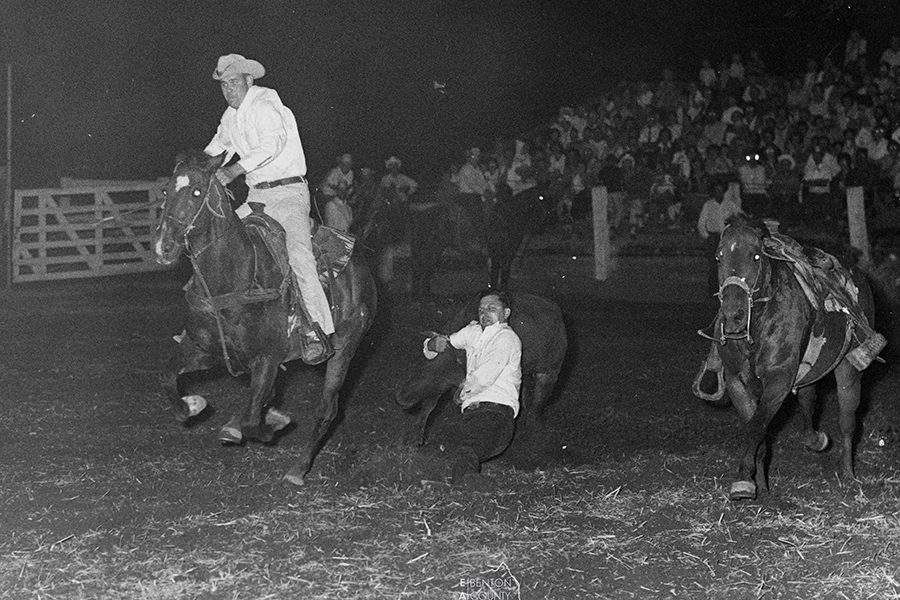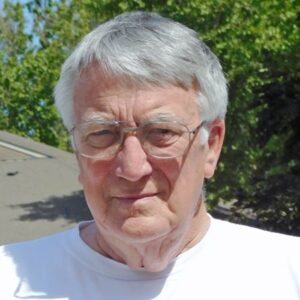
Home » Let’s giddyup to celebrate 75 years of fair rodeos
Let’s giddyup to celebrate 75 years of fair rodeos

Bulldogger John Gravenslund at the new fairgrounds in this 1962 photo by Roger S. Nielsen of Walla Walla.
Courtesy East Benton County Historical SocietyAugust 8, 2024
One Kennewick afternoon in 1949, a contestant slipped onto the back of a saddle-laden bronc and secured his hand for the ride ahead.
The cowboy and the animal were at cross purposes.
The man was on the beast’s back to ride a full 10 seconds.
The bronc furiously bucked to see that he did not.
It was a scene played out more than once that afternoon.
Sometimes the cowboy succeeded. Sometimes he flew off in a cloud of dust as his twisting bronc brought a quick end to his ride.
It truly was their first rodeo — at least here.
A fair history
Grape carnivals, town fairs, grape festivals and the first Benton County Fair in 1948 were the forerunners to the fair as we know it today.
But 1949 saw the addition of the rodeo.
This year marks three anniversaries of the Tri-Cities’ summer-ending signature event.
It’s the 75th anniversary of the first rodeo to be held in association with the fair here. This year’s diamond anniversary event started in the second year of what was then officially known as the Benton County Fair, following the Grape Festival in 1946 and 1947.
This year also marks the diamond anniversary of the fair being held at the current fairgrounds. Immediate fair activities before then had largely been held in downtown Kennewick and in the Keewaydin Park area.
This year also marks the 70th birthday of the official bi-county fair.
The first official Benton Franklin Fair was in 1954.
Royalty court for that first official bi-county fair included Queen Jene Mullineaux and princesses Joan Austin, Marlene Ross, Sondra Wade and Teddy Anderson. A sister of Princess Joan Austin, Sallie Austin, was queen of the 1958 Benton-Franklin Fair and Rodeo.
In a somewhat confusing timetable, last year’s fair in 2023 was billed as the 75th anniversary of the Benton-Franklin Fair.
The six fairs between 1948-53 were officially known as the Benton County Fair. But, because of strong support and participation by Franklin County during those years, that county was defacto considered by many participants as being included.
Regardless of how one views the timeline, tradition and history continue this year with the Benton Franklin Fair and its Horse Heaven Round-Up Rodeo running Aug. 20-24.
A rich tradition
Throughout all its history, that tradition has been rich.
Although the first rodeo was in 1949, an all-junior rodeo was featured as part of the 1948 fair with participants being 10- to 16-year-old cowgirls and cowboys.
The fair’s first two rodeos were daytime events. In 1951, electricians from the Benton County Public Utility District volunteered their time to hook up lights and the rodeo was held at night for the first time.
Visitors to the fair for the first several years were treated to free admission. By 1955, the Benton Franklin Fair was still one of only three fairs in Washington state admitting visitors at no cost.
It was also the fair participated in by a princess in the court of Queen Sondra Wade, who went on to become a dancer in the Radio City Music Hall Rockettes precision dance company in New York City.
Jo-Ann Hofmeister, a princess that year, is one of only 3,000 or so dancers to have been a part of the dance company in its 92-year history, beginning in 1932.
Visitors to the fair were finally charged admission beginning in 1957. They paid 50 cents to get in.
Famous fair and rodeo goers
That year’s rodeo in the arena here featured two of the most noteworthy figures in the history of rodeo, Harley May of Deming, New Mexico, and Deb Copenhaver, then of Post Falls, Idaho, but a Washington state native who died in Washington. Both are Hall of Famers.
May was world steer wrestling champion in 1952, 1956 and 1965, and in the top 15 of that event for 13 consecutive years.
He helped found the National Intercollegiate Rodeo Association, was its first all-around champion, and was the first college rodeo athlete to turn professional.
Deb Copenhaver, born in Wilbur in 1925, was inducted into both the National Rodeo Hall of Fame, and the National Cowboys Hall of Fame. He was a two-time World Saddle Bronc champion, winning back-to-back titles in 1955 and 1956.
The Benton Franklin Fair parade has featured both parade marshals selected for their commitment to benefiting and supporting the fair and individuals of note.
Robert Conrad, perhaps best known for his role in the “The Wild Wild West” television series, was grand marshal of the 1969 parade. Leo Carillo, sidekick of Duncan Renaldo in the 1940s, 1950s TV series “The Cisco Kid” also was a grand marshal.
Gale Metcalf of Kennewick is a lifelong Tri-Citian, retired Tri-City Herald employee and volunteer for the East Benton County Historical Museum. He writes the monthly history column.
Senior Times
KEYWORDS August 2024
Related Articles
Related Products




